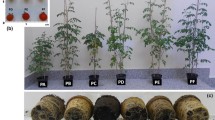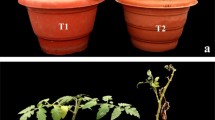Abstract
In the present work we have studied the accumulation of gentisic acid (2,5-dihydroxybenzoic acid, a metabolic derivative of salicylic acid, SA) in the plant-pathogen systems, Cucumis sativus and Gynura aurantiaca, infected with either prunus necrotic ringspot virus (PNRSV) or the exocortis viroid (CEVd), respectively. Both pathogens produced systemic infections and accumulated large amounts of the intermediary signal molecule gentisic acid as ascertained by electrospray ionization mass spectrometry (ESI-MS) coupled on line with high performance liquid chromatography (HPLC). The compound was found mostly in a conjugated (β-glucoside) form. Gentisic acid has also been found to accumulate (although at lower levels) in cucumber inoculated with low doses of Pseudomonas syringae pv. tomato, producing a nonnecrotic reaction. In contrast, when cucumber was inoculated with high doses of this pathogen, a hypersensitive reaction occurred, but no gentisic-acid signal was induced. This is consistent with our results supporting the idea that gentisic-acid signaling may be restricted to nonnecrotizing reactions of the host plant (Bellés et al. in Mol Plant-Microbe Interact 12:227–235, 1999). In cucumber and Gynura plants, the activity of gentisic acid as inducing signal was different to that of SA, thus confirming the data found for tomato. Exogenously supplied gentisic acid was able to induce peroxidase activity in both Gynura and cucumber plants in a similar way as SA or pathogens. However, gentisic-acid treatments strongly induced polyphenol oxidase activity in cucumber, whereas pathogen infection or SA treatment resulted in a lower induction of this enzyme. Nevertheless, gentisic acid did not induce other defensive proteins which are induced by SA in these plants. This indicates that gentisic acid could act as an additional signal to SA for the activation of plant defenses in cucumber and Gynura plants.







Similar content being viewed by others
Abbreviations
- CEVd:
-
Citrus exocortis viroid
- ESI-MS:
-
Electrospray ionization-mass spectrometry
- HPLC:
-
High performance liquid chromatography
- HR:
-
Hypersensitive response
- PR:
-
Pathogenesis-related
- PNRSV:
-
Prunus necrotic ringspot virus
- RT-PCR:
-
Reverse transcription-polymerase chain reaction
- SA:
-
Salicylic acid
- SIR:
-
Selected ion recording
References
Aparicio F, Myrta A, Di Terlizzi B, Pallás V (1999) Molecular variability among fifteen isolates of Prunus necrotic ringspot virus (PNRSV) from six different Prunus species. Phytopathology 89:991–999
Aramendía MA, García IM, Lafont F, Lizaso J, Marinas JM, Urbano FJ (2000) Rapid determination of chlorogenic acid and related compounds in sunflower seeds by high-performance liquid chromatography/atmospheric pressure chemical ionization mass spectrometry. Rapid Commun Mass Spectrom 14:1019–1022
Bednarek P, Winter J, Hamberger B, Oldham NJ, Schneider B, Tan J, Hahlbrock K (2004) Induction of 3′- O-β-D-ribofuranosyl adenosine during compatible, but not during incompatible, interactions of Arabidopsis thaliana or Lycopersicon esculentum with Pseudomonas syringae pathovar tomato. Planta 218:668–672
Bellés JM, Carbonell J, Conejero V (1991) Polyamines in plants infected by citrus exocortis viroid or treated with silver ions and ethephon. Plant Physiol 96:1053–1059
Bellés JM, Garro R, Fayos J, Navarro P, Primo J, Conejero V (1999) Gentisic acid as a pathogen-inducible signal, additional to salicylic acid for activation of plant defenses in tomato. Mol Plant Microbe Interact 12:227–235
Bestwick CS, Brown IR, Mansfield JW (1998) Localized changes in peroxidase activity accompany hydrogen peroxide generation during the development of a nonhost hypersensitive reaction in lettuce. Plant Physiol 118:1067–1078
Bradford MM (1976) A rapid and sensitive method for the quantitation of microgram quantities of protein utilizing the principle of protein-dye binding. Anal Biochem 72:248–254
Chong J, Pierrel M-A, Atanassova R, Werck-Reichhart D, Fritig B, Saindrenan P (2001) Free and conjugated benzoic acid in tobacco plants and cell cultures. Induced accumulation upon elicitation of defense responses and role as salicylic acid precursors. Plant Physiol 125:318–328
Conejero V, Bellés JM, García-Breijo F, Garro R, Hernández-Yago J, Rodrigo I, Vera P (1990) Signalling in viroid pathogenesis. In: Fraser RSS (eds) Recognition and response in plant-virus interactions. Springer, Berlin Heidelberg New York pp 233–261
Constabel CP, Bergey DR, Ryan CA (1995) Systemin activates synthesis of wound-inducible tomato leaf polyphenol oxidase via the octadecanoid defense signaling pathway. Proc Natl Acad Sci USA 92:407–411
Dangl JL, Jones JDG (2001) Plant pathogens and integrated defense responses to infection. Nature 411:826–833
Delaney TP, Uknes S, Vernooij B, Friedrich L, Weymann K, Negrotto D, Gaffney T, Gut-Rella M, Kessmann H, Ward E, Ryals J (1994) A central role of salicylic acid in disease resistance. Science 266:1247–1250
Dixon RA (2001) Natural products and plant disease resistance. Nature 411:843–847
Dixon RA, Paiva NL (1995) Stress-induced phenylpropanoid meabolism. Plant Cell 7:1085–1097
Dixon RA, Harrison JJ, Lamb CJ (1994) Early events in the activation of plant defense responses. Annu Rev Phytopathol 32:479–501
Dixon RA, Achnine L, Kota P, Liu C-J, Reddy MSS, Wang L (2003) The phenylpropanoid pathway and plant defence –a genomics perspective. Mol Plant Pahol 3:371–390
Enyedi AJ, Yalpani N, Silverman P, Raskin I (1992a) Localization, conjugation and function of salicylic acid in tobacco during the hypersensitive reaction to tobacco mosaic virus. Proc Natl Acad Sci USA 89:2480–2484
Enyedi AJ, Yalpani N, Silverman P, Raskin I (1992b) Signal molecules in systemic plant resistance to pathogens and pests. Cell 70:879–886
Hagemeier J, Schneider B, Oldham NJ, Hahlbrock K (2001) Accumulation of soluble and wall-bound indolic metabolites in Arabidopsis thaliana leaves infected with virulent or avirulent Pseudomonas syringae pathovar tomato strains. Proc Natl Acad Sci USA 98:753–758
Halbrock K, Sheel D (1989) Physiology and molecular biology of phenylpropanoid metabolism. Annu Rev Plant Physiol Plant Mol Biol 40:347–369
Hammerschmidt R, Nuckles EM, Kuc J (1982) Association of enhanced peroxidase activity with induced systemic resistance of cucumber to Colletotrichum lagenarium. Physiol Plant Pathol 20:73–82
He X-Z, Dixon RA (2000) Genetic manipulation of isoflavone 7-O-methyltransferase enhances biosynthesis of 4′-O-methylated isoflavonoid phytoalexins and disease resistance in alfalfa. Plant Cell 12:1689–1702
Hipskind JD, Paiva NL (2000) Constitutive accumulation of a resveratrol-glucoside in transgenic alfalfa increases resistance to Phoma medicaginis. Mol Plant Microbe Interact 13:551–562
Huang J, Cardoza YJ, Schmelz EA, Raina R, Engelberth J, Tumlinson JH (2003) Differential volatile emissions and salicylic acid levels from tobacco plants in response to different strains of Pseudomonas syringae. Planta 217:767–775
Koike N, Hyaskumachi M, Kageyama K, Tsuyumu S, Doke N (2001) Induction of systemic resistance in cucumber against several diseases by plant growth-promoting fungy: lignification and superoxide generation. Eur J Plant Pathol 107:523–533
Lattanzio V, De Cicco D, Di Venere, D Lima G, Salerno M (1994) Antifungal activity of phenolics against fungi comonly encountered during storage. Ital J Food Sci 6:23–30
Li L, Steffens JC (2002) Overexpression of polyphenol oxidase in transgenic tomato plants results in enhanced bacterial disease resistance. Planta 215:239–247
Maher EA, Bate NJ, Ni W, Elkind Y, Dixon RA, Lamb C (1994) Increased disease susceptibility o transgenic tobacco plants with suppressed levels of preformed phenylpropanoid products. Proc Natl Acad Sci USA 9:7802–7806
Malamy J, Henning J, Klessig DF (1992) Temperature-dependent induction of salicylic acid and its conjugates during the resistance response to tobacco mosaic virus infection. Plant Cell 4:359–366
Martinez C, Baccou J-C, Bresson E, Baissac Y, Daniel J-F, Jalloul A, Montillet J-L, Geiger J-P, Assigbetsé K, Nicole M (2000) Salicylic acid mediated by the oxidative burst is a key molecule in local and systemic responses of cotton challenged by an avirulent race of Xanthomonas campestris pv malvacearum. Plant Physiol 122:757–766
Meera MS, Shivanna MB, Kageyama K, Hyakumachi M (1994) Plant growth-promoting fungi from zoysiagrass rhizosphere as potential inducers of systemic resistance in cucumbers. Phytopathol 84:1399–1406
Métraux JP, Burkhart W, Moyer M, Dincher S, Middlesteadt W, Williams S, Payne G, Carnes M, Ryals J (1989) Isolation of a complementary DNA encoding a chitinase with structural homology to a bifunctional lysozyme/chitinase. Proc Natl Acad Sci USA 86:896–900
Métraux JP, Signer HJ, Ryals J, Ward E, Wyss-Benz M, Gaudin J, Raschdorf K, Schmid E, Blum W, Inverardi B (1990) Increase in salicylic acid at the onset of systemic acquired resistance in cucumber. Science 250:1004–1006
Meuwly P, Mölders W, Buchala A, Métraux JP (1995) Local and systemic biosynthesis of salicylic acid in infected cucumber plants. Plant Physiol 109:1107–1114
Nagai T, Suzuki N (2001) Partial purification of poyphenol oxidase from Chinese Cabbage Brassica rapa L. J Agric Food Chem 49:3922–3926
Naranjo MA, Romero C, Bellés JM, Montesinos C, Vicente O, Serrano R (2003) Lithium treatment induces a hypersensitive-like response in tobacco. Planta 217:417–424
O’Donnell PJ, Jones JB, Antoine FR, Ciardi J, Klee HJ (2001) Ethylene-dependent salicylic acid regulates an expanded cell death response to a plant pathogen. Plant J 25:315–323
Pallas JA, Paiva NL, Lamb CJ, Dixon RA (1996) Tobacco plants epigenetically suppressed in phenylalanine ammonia-lyase expression do not develop systemic acquired resistance to pathogen attack. Plant J 10:281–293
Raskin I, Turner IM, Melander WR (1989) Regulation of heat production in the inflorescences of an Arum lily by endogenous salicylic acid. Proc Natl Acad Sci USA 86:2214–2218
Rasmussen JB, Hammerschmidt R, Zook MN (1991) Systemic induction of salicylic acid accumulation in cucumber after inoculation with Pseudomonas syringae pv syringae. Plant Physiol 97:1342–1347
Rodríguez JL, Flores R (1987) Effects of citrus exocortis viroid infection on the peroxidase/IAA-oxidase system of Gynura aurantiaca and Lycopersicon esculentum. Biochem Physiol Pflanzen 182:449–457
Sánchez-Navarro JA, Aparicio F, Rowhani A, Pallás V (1998) Comparative analysis of ELISA, nonradioactive molecular hybridization and PCR for the detection of prunus necrotic ringspot virus in herbaceous and Prunus hosts. Plant Pathol 47:780–786
Shadle GL, Wesley SV, Korth KL, Chen F, Lamb C, Dixon RA (2003) Phenylpropanoid compounds and disease resistance in transgenic tobacco with altered expression of L-phenylalanine ammonia-lyase. Phytochemistry 64:153–161
Shah J, Klessig DF (1999) Salicylic acid: signal perception and transduction. In: Hooykaas PJJ, Hall MA, Libbenga KR (eds) Biochemistry and molecular biology of plant hormones. Elsevier Science, Amsterdam, pp 513–541
Smith-Becker J, Marois E, Huguet EJ, Midland SL, Sims JJ, Keen NT (1998) Accumulation of salicylic acid and 4-hydroxybenzoic acid in phloem fluids of cucumber during systemic acquired resistance is preceded by a transient increase in phenylalanine ammonia-lyase activity in petioles and stems. Plant Physiol 11:231–238
Staskawicz BJ, Ausubel FM, Baker BJ, Ellis JG, Jones JDG (1995) Molecular genetics of plant disease resistance. Science 268:661–667
Summermatter K, Sticher L, Métraux JP (1995) Systemic responses in Arabidopsis thaliana infected and challenged with Pseudomonas syrngae pv syringae. Plant Physiol 108:1379–1385
Willoughby R, Sheehan E, Mitrovich S (2002) A global view of LC/MS, 2nd edn. Global View Publishing. Pittsburgh
Yalpani N, Schulz M, Davis MP, Balke NE (1992) Partial purification and properties of an inducible uridine 5′diphosphate-glucose: salicylic acid glucosyltransferase from oat roots. Plant Physiol 100:457–463
Zhou N, Tootle TL, Tsui F, Klessig DF, Glazebrook J (1998) Pad4 functions upstream from salicylic acid to control defense responses in Arabidopsis. Plant Cell 10:1021–1030
Acknowledgements
The authors wish to thank the reviewers for their helpful suggestions, Dr Pablo Vera for the gift of Pseudomonas syringae pv tomato cultures and Dr Vicente Noguera for the gift of cucumber seeds. Dr Josep Lluís Llibería (Waters Corporation) is also acknowledged for his continuous support in the MS techniques. This work has been supported by grant#BMC2000-1136 from Comisión Interministerial de Ciencia y Tecnología, Spanish Ministry of Science and Technology.
Author information
Authors and Affiliations
Corresponding author
Rights and permissions
About this article
Cite this article
Bellés, J.M., Garro, R., Pallás, V. et al. Accumulation of gentisic acid as associated with systemic infections but not with the hypersensitive response in plant-pathogen interactions. Planta 223, 500–511 (2006). https://doi.org/10.1007/s00425-005-0109-8
Received:
Accepted:
Published:
Issue Date:
DOI: https://doi.org/10.1007/s00425-005-0109-8




